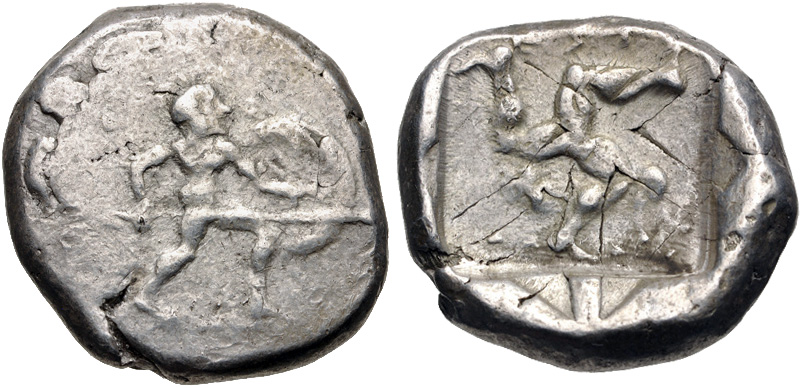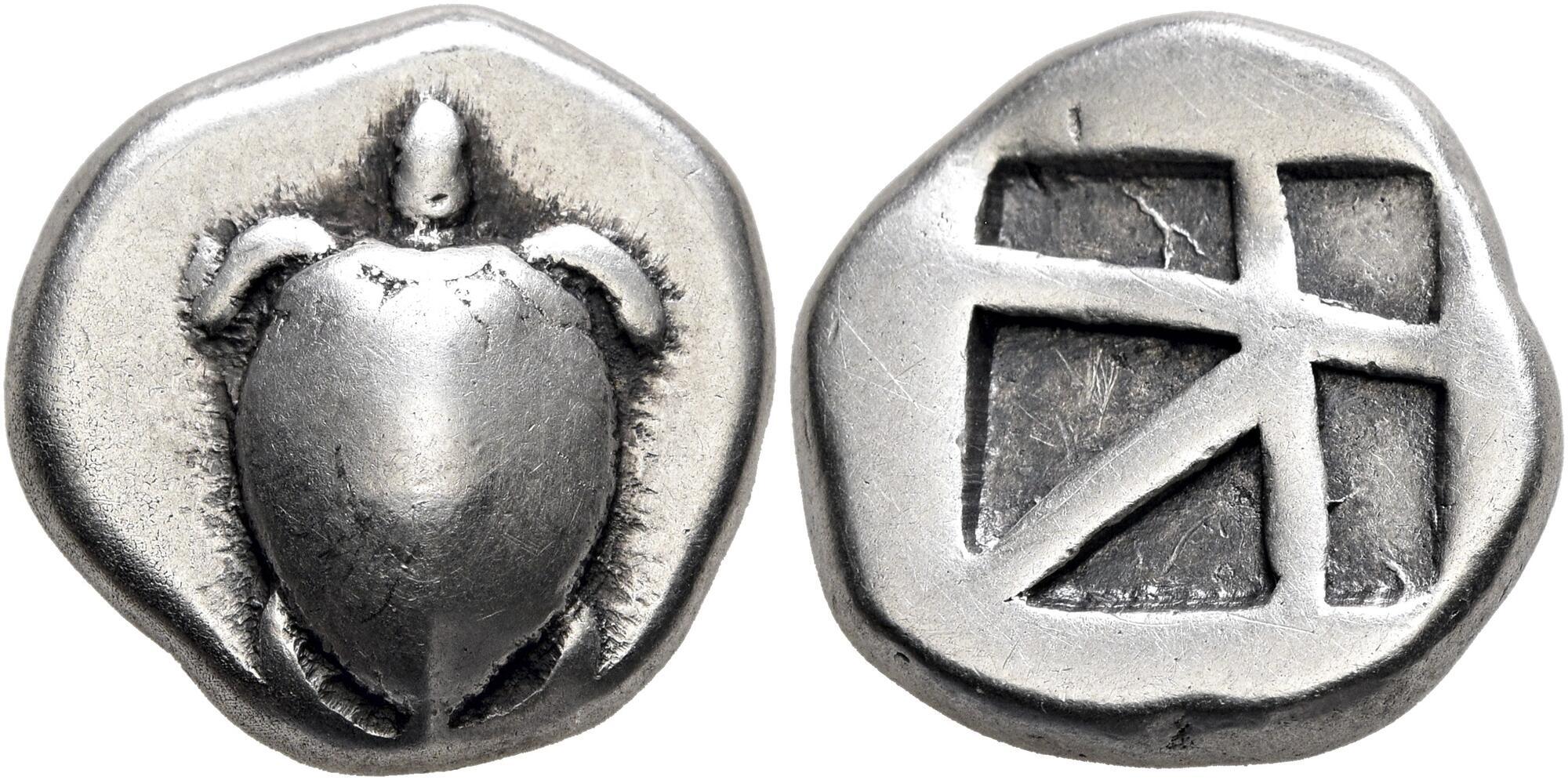2330 - Aspendus (double siglos hoplite/triskeles) over Aegina (turtle/incuse square) (CNG, EA 446, June 2019, 99): Difference between revisions
From SILVER
No edit summary |
No edit summary |
||
| Line 12: | Line 12: | ||
|Ancient region=Pamphylia | |Ancient region=Pamphylia | ||
|Authority=Persian Empire | |Authority=Persian Empire | ||
|Date from= | |Date from=466 BCE | ||
|Date to=430 BCE | |Date to=430 BCE | ||
|Period=Classical | |Period=Classical | ||
Revision as of 20:45, 29 July 2023
466 BCE - 430 BCE | ΕΣΤ
Location/history
| Sale(s)Sale(s) ᵖ: | Classical Numismatic Group, EA 446, 19 June 2019, 99 | |
Overstriking coin
Description
| ObverseInscription or printing placed on the obverse.: | Warrior walking right, naked, wearing helmet, holding spear in right hand, shield attached on left arm. | ReverseInscription or printing placed on the reverse.: | ΕΣΤ (Greek) Triskeles of human legs. Behind, lion crouching left. All within incuse square. |
Mint and issuing power
| MintIdentifies the place of manufacture or issue of a numismatic object.: | Aspendus | Ancient regionAncient region. | Pamphylia | Modern countryModern country: Turkey | AuthorityIdentifies the issuing power. The authority can be "pretended" when the name or the portrait of X is on the coin but he/she was not the issuing power. It can also be "uncertain" when there is no mention of X on the coin but he/she was the issuing power according to the historical sources: | Persian Empire |
Chronology
| FromIdentifies the initial date in a range assigned in a numismatic context. 466 BCE toIdentifies the final date in a range assigned in a numismatic context.. 430 BCE | Classical 480-323 BC |
Physical description
| MetalThe physical material (usually metal) from which an object is made.: Silver |
WeightWeight of the numismatic object (in grams). in grams: 10.9710.97 g <br />10,970 mg <br /> | DenominationTerm indicating the value of a numismatic object. Examples: tetradrachm, chalkous, denarius.: double siglos |
AxisDescribes the directional relationship between the obverse and reverse of a numismatic object.: 1010 mm <br />1 cm <br /> |
| DiameterDescribes diameter of an object (in mm).: 2020 mm <br />2 cm <br /> | StandardStandard.: Persian | ||
References
| Coin referenceReference of the Coin: | Coin series referenceReference to coin series study: | Babelon 19011Babelon 1901, Part 2, Tome 1, p. 526-530, n° 869-70, SNG von Aulock Pamphylien2SNG von Aulock Pamphylien, n° 4484, SNG France 33SNG France 3, n° 12-13 | |
| Coin series web referenceCoin series web references: | |||
Overstruck type
Description
| ObverseInscription or printing placed on the obverse.: | Sea turtle (visible on obverse) | ReverseInscription or printing placed on the reverse.: | visible on reverse: quadripartite incuse square. |
Mint and issuing power
| MintIdentifies the place of manufacture or issue of a numismatic object. ᵖ: | Aegina | Ancient regionAncient region. ᵖ | Aegina | Modern countryModern country: Greece | AuthorityIdentifies the authority in whose name (explicitly or implicitly) a numismatic object was issued. ᵖ: |
Chronology
| FromIdentifies the initial date in a range assigned in a numismatic context. 480 BCE toIdentifies the final date in a range assigned in a numismatic context.. 457 BCE | Archaic until 480 BC |
Physical description
| DenominationTerm indicating the value of a numismatic object. Examples: tetradrachm, chalkous, denarius. ᵖ: | stater |
StandardStandard. ᵖ: | Aeginetic |
References
| Coin type referenceReference to coin series study ᵖ: | HGC 64HGC 6, n° 436-442, Meadows (forthcoming)5Meadows (forthcoming), Groups IIa-IIb | ||
| Coin series web reference overstruckCoin series web references overstruck: | |||
Additional data
| Frequency of overstrikesFrequency of overstrikes: | frequent | Level of confidenceLevel of confidence of the identification: | sure |
| RemarksRemarks: | "overstruck an a stater of Aegina" | ||

